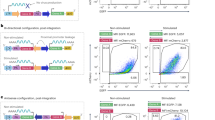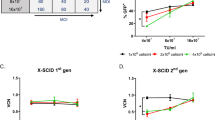Abstract
Difficulty in gene transduction of human blood cells, including hematopoietic stem cells, has hampered the development of gene therapy applications for hematological disorders, encouraging the development and use of new gene delivery systems. In this study, we used a third-generation self-inactivating (SIN) lentiviral vector system based on human immunodeficiency virus type 1 (HIV-1) to improve transduction efficiency and prevent vector-related toxicity. The transduction efficiency of the HIV-1-based vector was compared directly with the Moloney murine leukemia virus (MLV) SIN vector in human leukemia cell lines. Initial transduction efficiencies were almost 100% for the HIV and less than 50% for the MLV vectors. Similar results were observed in 11 types of primary cells obtained from leukemia or myeloma patients. Transgene expression persisted for 8 weeks in cells transduced with the HIV vector, but declined with the MLV vector. In addition, resting peripheral blood lymphocytes and CD34+ hematopoietic cells were transduced successfully with the HIV vector, but not with the MLV vector. Finally, we confirmed vector gene integration in almost all colony-forming cells transduced with the HIV vector, but not with the MLV vector. In conclusion, this lentiviral vector is an excellent gene transduction system for human blood cells because of its high gene transduction and host chromosome integration efficiency.
This is a preview of subscription content, access via your institution
Access options
Subscribe to this journal
Receive 12 print issues and online access
$259.00 per year
only $21.58 per issue
Buy this article
- Purchase on Springer Link
- Instant access to full article PDF
Prices may be subject to local taxes which are calculated during checkout









Similar content being viewed by others
References
Tani K et al. Retrovirus-mediated gene transfer of human pyruvate kinase (PK) cDNA into murine hematopoietic cells: implications for gene therapy of human PK deficiency. Blood 1994; 83: 2305–2310.
Miyoshi H et al. Transduction of human CD34+ cells that mediate long-term engraftment of NOD/SCID mice by HIV vectors. Science 1999; 283: 682–686.
Case SS et al. Stable transduction of quiescent CD34(+)CD38(−) human hematopoietic cells by HIV-1-based lentiviral vectors. Proc Natl Acad Sci USA 1999; 96: 2988–2993.
Salmon P et al. High-level transgene expression in human hematopoietic progenitors and differentiated blood lineages after transduction with improved lentiviral vectors. Blood 2000; 96: 3392–3398.
Mascarenhas L et al. Gene delivery to human B-precursor acute lymphoblastic leukemia cells. Blood 1998; 92: 3537–3545.
Kuwabara T et al. A novel allosterically trans-activated ribozyme, the maxizyme, with exceptional specificity in vitro and in vivo. Mol Cell 1998; 2: 617–627.
Tanabe T et al. Oncogene inactivation in a mouse model. Nature 2000; 406: 473–474.
Stripecke R et al. Lentiviral vectors for efficient delivery of CD80 and granulocyte-macrophage-colony-stimulating factor in human acute lymphoblastic leukemia and acute myeloid leukemia cells to induce antileukemic immune responses. Blood 2000; 96: 1317–1326.
Luther-Wyrsch A et al. Stable transduction with lentiviral vectors and amplification of immature hematopoietic progenitors from cord blood of preterm human fetuses. Hum Gene Ther 2001; 12: 377–389.
Chinnasamy D et al. Lentiviral-mediated gene transfer into human lymphocytes: role of HIV-1 accessory proteins. Blood 2000; 96: 1309–1316.
Donello JE, Loeb JE, Hope TJ . Woodchuck hepatitis virus contains a tripartite posttranscriptional regulatory element. J Virol 1998; 72: 5085–5092.
Zennou V et al. HIV-1 genome nuclear import is mediated by a central DNA flap. Cell 2000; 101: 173–185.
Sirven A et al. The human immunodeficiency virus type-1 central DNA flap is a crucial determinant for lentiviral vector nuclear import and gene transduction of human hematopoietic stem cells. Blood 2000; 96: 4103–4110.
Dardalhon V et al. Lentivirus-mediated gene transfer in primary T cells is enhanced by a central DNA flap. Gene Therapy 2001; 8: 190–198.
Sastry L et al. Titering lentiviral vectors: comparison of DNA, RNA and marker expression methods. Gene Therapy 2002; 9: 1155–1162.
Benkirane M, Corbeau P, Housset V, Devaux C . An antibody that binds the immunoglobulin CDR3-like region of the CD4 molecule inhibits provirus transcription in HIV-infected T cells. EMBO J 1993; 12: 4909–4921.
Butler SL, Hansen MS, Bushman FD . A quantitative assay for HIV DNA integration in vivo. Nat Med 2001; 7: 631–634.
Bouyac-Bertoia M et al. HIV-1 infection requires a functional integrase NLS. Mol Cell 2001; 7: 1025–1035.
O’Doherty U et al. A sensitive, quantitative assay for human immunodeficiency virus type 1 integration. J Virol 2002; 76: 10942–10950.
Uchiyama T, Broder S, Waldmann TA . A monoclonal antibody (anti-Tac) reactive with activated and functionally mature human T cells. I. Production of anti-Tac monoclonal antibody and distribution of Tac (+) cells. J Immunol 1981; 126: 1393–1397.
Malavasi F et al. CD38: a multi-lineage cell activation molecule with a split personality. Int J Clin Lab Res 1992; 22: 73–80.
Ziegler SF, Ramsdell F, Alderson MR . The activation antigen CD69. Stem Cells 1994; 12: 456–465.
Vigna E, Naldini L . Lentiviral vectors: excellent tools for experimental gene transfer and promising candidates for gene therapy. J Gene Med 2000; 2: 308–316.
Dull T et al. A third-generation lentivirus vector with a conditional packaging system. J Virol 1998; 72: 8463–8471.
Miyoshi H et al. Development of a self-inactivating lentivirus vector. J Virol 1998; 72: 8150–8157.
Sastry KJ et al. Expression of human immunodeficiency virus type I tat results in down-regulation of bcl-2 and induction of apoptosis in hematopoietic cells. Oncogene 1996; 13: 487–493.
Wu X, Holschen J, Kennedy SC, Ponder KP . Retroviral vector sequences may interact with some internal promoters and influence expression. Hum Gene Ther 1996; 7: 159–171.
Hansen MS et al. Retroviral cDNA integration: mechanism, applications and inhibition. Genet Eng (NY) 1998; 20: 41–61.
Li L et al. Role of the non-homologous DNA end joining pathway in the early steps of retroviral infection. EMBO J 2001; 20: 3272–3281.
Rivella S, Sadelain M . Genetic treatment of severe hemoglobinopathies: the combat against transgene variegation and transgene silencing. Semin Hematol 1998; 35: 112–125.
Challita PM, Kohn DB . Lack of expression from a retroviral vector after transduction of murine hematopoietic stem cells is associated with methylation in vivo. Proc Natl Acad Sci USA 1994; 91: 2567–2571.
Ghazizadeh S, Carroll JM, Taichman LB . Repression of retrovirus-mediated transgene expression by interferons: implications for gene therapy. J Virol 1997; 71: 9163–9169.
Lanotte M et al. NB4, a maturation inducible cell line with t(15;17) marker isolated from a human acute promyelocytic leukemia (M3). Blood 1991; 77: 1080–1086.
Setoyama M et al. A unique translocation of the TEL gene in a case of acute myelogenous leukemia with inv(12)(p13q15). Blood 1998; 92: 1454–1455.
Pegoraro L et al. Establishment of a Ph1-positive human cell line (BV173). J Natl Cancer Inst 1983; 70: 447–453.
Ohyashiki K et al. Interleukin-7 enhances colony growth and induces CD20 antigen of a Ph+ acute lymphoblastic leukemia cell line, OM9;22. Leukemia 1993; 7: 1034–1040.
Soda Y et al. Establishment of a new system for determination of coreceptor usages of HIV based on the human glioma NP-2 cell line. Biochem Biophys Res Commun 1999; 258: 313–321.
Yu SF et al. Self-inactivating retroviral vectors designed for transfer of whole genes into mammalian cells. Proc Natl Acad Sci USA 1986; 83: 3194–3198.
Landau NR, Littman DR . Packaging system for rapid production of murine leukemia virus vectors with variable tropism. J Virol 1992; 66: 5110–5113.
Onishi M et al. Applications of retrovirus-mediated expression cloning. Exp Hematol 1996; 24: 324–329.
Acknowledgements
We thank Dr IM Verma (Salk Institute, La Jolla, CA, USA) and Cell Genesys for providing HIV vector constructs. We also express our gratitude to Drs DR Littman, T Kitamura, K Ohyashiki, F Nagamura (University of Tokyo), and G Veres (Cell Genesys) for kindly providing us with pSV-Ψ−-env−-MLV plasmid, pMX plasmid, OM9; 22 cells, IMS-M2 cells and helpful discussion, respectively. We are grateful to Dr H Urano (Ikuryo clinic, Tokyo, Japan) for providing us with cord blood samples. We also appreciate Dr T Iseki and the hospital staff of the Research Hospital of Institute of Medical Science, University of Tokyo for their support in sample collection from patients. We are indebted to Drs N Watanabe and D Sugiyama (University of Tokyo) for suggestions regarding the multicolor FCM and to Dr Y Nakazaki, Dr E Sasaki, Mr K Takahashi, Mrs M Oiwa, and Mrs S Suzuki (University of Tokyo) for technical support. YB and YS are awardees of Research Fellowship of the Japan Society of the Promotion of Science for Young Scientists. This work was supported in part by a Grant-in-aid from the Ministry of Education, Science, Sports and Culture, and the Ministry of Health, Labor and Welfare of Japan.
Author information
Authors and Affiliations
Rights and permissions
About this article
Cite this article
Bai, Y., Soda, Y., Izawa, K. et al. Effective transduction and stable transgene expression in human blood cells by a third-generation lentiviral vector. Gene Ther 10, 1446–1457 (2003). https://doi.org/10.1038/sj.gt.3302026
Received:
Accepted:
Published:
Issue Date:
DOI: https://doi.org/10.1038/sj.gt.3302026
Keywords
This article is cited by
-
Functional characterization of lysosomal interaction of Akt with VRK2
Oncogene (2018)
-
Gene set enrichment analysis provides insight into novel signalling pathways in breast cancer stem cells
British Journal of Cancer (2010)
-
Generation of transgenic non-human primates with germline transmission
Nature (2009)
-
RNAi-mediated silencing of p190Bcr-Abl inactivates Stat5 and cooperates with imatinib mesylate and 17-allylamino-17-demetoxygeldanamycin in selective killing of p190Bcr-Abl-expressing leukemia cells
Leukemia (2008)
-
Construction of a high-performance human fetal liver-derived lentiviral cDNA library
Molecular and Cellular Biochemistry (2008)



